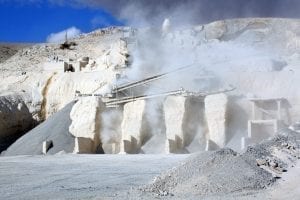If you need assistance with silica exposure discussed in this article, call us at 973-366-4660 or e-mail us at info@atlenv.com for details and a free estimate.
Written By: Robert E. Sheriff, MS, CIH, CSP, President
February 6, 2020; Updated November 2021
What is a Safe Level of Silica Exposure in Community and Residential Situations??
Although there is an OSHA Silica Standard, this only applies to workers based on an 8-hour workday.
In non-occupational situations, as in a residential area or community, this is not an adequate standard to protect individuals since the potential exposure can be 24 hours per day, seven (7) days a week, 365 days a year.
Silica Identified
Accepting the fact that silica has been identified as a cancer-causing substance, the concern is well justified. There are many residential areas/communities where the potential for exposure to silica is very real. Primary examples are rock quarries and road and building construction areas, as well as sand and gravel operations, concrete mixing facilities, and oil/gas fracking since all three use large quantities of sand.
Sand – The Basic Source of Crystalline Silica
 Sand is the primary source of crystalline silica the “silica agent” that produces the disease silicosis (a scarring of the lungs) and lung cancer. Crystalline silica is developed when sand is fractured (primarily due to friction) which creates particles of sharp, fractured dust. These sharp, glass-like particles can be small enough to be inhaled into the lungs, where they can scar the delicate lung tissue. If the scarring is significant enough, it progressively damages healthy lung tissue with continued scarring. It can even lead to a total deterioration of lung tissues, which is the disease called silicosis. At the same time, scarring can also result in the development of lung cancer.
Sand is the primary source of crystalline silica the “silica agent” that produces the disease silicosis (a scarring of the lungs) and lung cancer. Crystalline silica is developed when sand is fractured (primarily due to friction) which creates particles of sharp, fractured dust. These sharp, glass-like particles can be small enough to be inhaled into the lungs, where they can scar the delicate lung tissue. If the scarring is significant enough, it progressively damages healthy lung tissue with continued scarring. It can even lead to a total deterioration of lung tissues, which is the disease called silicosis. At the same time, scarring can also result in the development of lung cancer.
Are There Safe Levels of Airborne Silica Outdoors?
There is no recommended, safe level of airborne silica outdoors or in any non-occupational setting. Several states have adopted “safe limits” for non-occupational exposure. They include California, New Jersey, Minnesota, Vermont, and Texas.
The dilemma found in these states, or anywhere in the Continental U.S., is that the accepted method for sampling and analysis is the OSHA Method (NIOSH 7500) but this is not sensitive enough to reach the state’s limit of 3.0 ug/M3. (Note: The OSHA limit is 50 ug/M3 and the detection limit is 5 ug/M3).
 There are other methods for sampling outdoor air, such as PM 10 and PM 2.5, but these methods cannot identify the amount of silica in the sample. The OSHA method considers respirable silica, often referred to as PM 4.0, and specifically identifies the amount of silica in the sample.
There are other methods for sampling outdoor air, such as PM 10 and PM 2.5, but these methods cannot identify the amount of silica in the sample. The OSHA method considers respirable silica, often referred to as PM 4.0, and specifically identifies the amount of silica in the sample.
A new method exists that can achieve the state’s limit of 3.0 ug/M3 of PM 4.0, can identify the silica content, and can reach the analytical sensitivity to achieve the 3.0 ug/M3 level by sampling for 8 hours or longer. The method uses an SKC, Inc. sampling cassette which samples at 8 LPM (liters per minute) and analyzes the sample by the accepted method of NIOSH 7500.
Atlantic Environmental, Inc. has the equipment and knowledge to use this method to sample outdoors or in any building (commercial/residential) to determine if the silica levels are within the recommended 3.0 ug/M3 level.
To find out if your community/residential property has a safe level of silica exposure to its occupants, contact us at info@atlenv.com, call us at 973-366-4660 or use our online form for more details or a quote.
Our primary service areas are New Jersey NJ, New York NY, (New York City), Pennsylvania PA, Connecticut CT, Delaware DE, Massachusetts, (Boston) MA, Rhode Island RI, Washington DC, Wisconsin WI, Maryland MD, Michigan MI, Illinois (Chicago) IL, Virginia VA, Indiana IN, Georgia (Atlanta) GA, Alabama AL, North Carolina NC, South Carolina SC, Tennessee TN, Texas (Dallas, Ft Worth) TX, Oklahoma OK, DC, Arkansas AR, Florida FL. We can service most other areas of the U.S. but additional travel charges will be applied.
References
Environmental Working Group (EWG), “Danger in the Air: Health Concerns for Silica in Outdoor Air, www.ewg.org/research/sandstorm/health-concerns-silica-outdoor-air
Public Lab, Silica Monitoring, www.public lab.org/wiki/silica-monitoring
Bhagia, J.L., “Non-Occupational Exposure to Silica Dust,” Indian Journal of Occupational and Environmental Medicine, September-December 2012, 16 (3), pages 95-100.
Gehrke, G., “Airborne Silica and Regulations,” Public Lab, publiclab.org/notes/mlamadrid/06-21-2016\airborne-silica-and-regulations.



